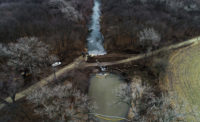The utility noted its prior commitment to spend $2.7 billion of shareholder money to test and upgrade its system and that it has completed nine of 12 NTSB safety recommendations, with with work on three others in progress.
The firm had announced in a March 27 Securities and Exchange Commission filing that the expected criminal charges would have a financial impact and that its gas business may be subject to “oversight of an independent monitor.”
It also announced April 1 that it would release first quarter earnings on May 1.
PG&E is already facing a potential $2.25 billion fine for safety violations related to San Bruno proposed by California safety regulators—the largest fine ever proposed for a pipeline operator, in a case being closely watched by the gas industry.
Questions
One pipeline industry official questioned the indictment.
Brigham McCown, a former administrator of the US Pipeline and Hazardous Materials Safety Administration who consults to the industry told Platt's: “A lot of the indictment
leaves me with more questions than answers. The San Bruno pipe predates
a lot of these regulations."
He added that, “To be found criminally liable a person or corporation must have knowledge and willfully disregard the law. It’s a very tough standard
to make and reach. No one knew that segment of [bad] pipeline existed
until after the explosion. I just don’t know how you get there.”
But such criminal charges have some precedence.
Gasoline system operator Olympic Pipe Line and two of its employees faced criminal charges after a June 2009 incident in which gasoline that leaked from its system into a river in Bellingham, Wash., ignited and killed three boys fishing nearby.
The company’s pipeline manager served six months in prison; a control room supervisor served one month.
One observer noted that natural gas safety has been under the microscope lately, particularly after a New York City explosion killed eight people last month and is suspected to have been caused by gas leaking from a nearby main.




Post a comment to this article
Report Abusive Comment